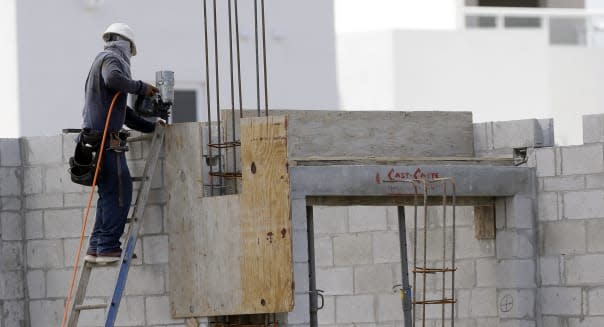Weekly Jobless Claims Hit 8-Week Low; Housing Starts Fall

By Lucia Mutikani
WASHINGTON -- The number of Americans filing new applications for unemployment benefits fell last week to the lowest level in eight weeks, suggesting the labor market continued to strengthen despite the recent tightening in financial market conditions.
While other data on Thursday showed housing starts fell for a second straight month in August, they remained above the one million-unit mark, which signals a housing market growing at a solid clip. In addition, building permits rose last month.
%VIRTUAL-pullquote-Speculation will now shift to December as the next most likely month for U.S. rates to start rising.%The signs of a firming economy are supportive of an interest rate hike by the Federal Reserve later this year, after the U.S. central bank Thursday kept borrowing costs near zero, citing concerns about the global economy.
"Speculation will now shift to December as the next most likely month for U.S. rates to start rising," said Chris Williamson, chief economist at Markit in London.
"The 'data dependent' Fed will want to see further robust non-farm payroll growth between now and then as well as indications that the pace of economic growth is not wilting under the pressure of China's slowdown."
Initial claims for state unemployment benefits dropped 11,000 to a seasonally adjusted 264,000 for the week ended Sept. 12, the Labor Department said. That was the best reading since the week ended July 18, when claims hit their lowest level since 1973.
It marked the 28th straight week that claims remained below the 300,000 threshold, which is usually associated with a strengthening labor market. Economists had forecast claims holding at 275,000 last week.
The dollar fell against a basket of currencies on the Fed's rate decision, while prices for U.S. Treasury debt rallied. Stocks on Wall Street rose in volatile trade.
Firming Labor Market
The claims data covered the period during which the government surveyed employers for the nonfarm payrolls portion of the September employment report. Claims fell 13,000 between the August and September survey weeks, suggesting some pickup in job growth after slowing in August.
Labor market conditions are tightening, with record high job openings. At a 7½-year low of 5.1 percent, the unemployment rate is within the range most Fed officials think is consistent with a low but steady rate of inflation.
In a second report, the Commerce Department said groundbreaking for new homes dropped 3 percent to a seasonally adjusted annual pace of 1.13 million units last month.
Despite the fall, which reflected declines in groundbreaking on single and multifamily projects, starts remained above a one million-unit pace for the fifth straight month. Building permits increased 3.5 percent last month to a 1.17 million-unit pace, after declining 15.5 percent in July.
"The small dip in August housing starts is minor considering the sustained momentum we've seen in housing overall in 2015," said Bill Banfield, vice president at Quicken loans in Detroit.
"When you couple the slow but steady rise in single-family unit construction with an increase in builder confidence, it's further support that housing is returning to its place as a major player in driving economic growth."
%VIRTUAL-WSSCourseInline-840%The firming labor market has unleashed pent-up demand for housing, especially among young adults. A report Wednesday showed confidence among homebuilders advancing to a near decade high in September.
In August, groundbreaking for single-family homes, which accounts for the largest share of the market, fell 3 percent to a 739,000 unit pace. Single-family home building in the South, where most of the home construction takes place, rose 9.2 percent to the highest level since December 2007.
Starts for the volatile multifamily segment fell 3 percent to a 387,000 unit rate. Single-family building permits rose 2.8 percent in August to their highest level since January 2008. Multifamily building permits rose 4.7 percent.
A third report showed manufacturing continued to struggle against the headwinds of a strong dollar and soft global demand.
The Philadelphia Fed said its business activity index fell to minus 6 in September from positive 8.3 in August. A reading below zero indicates contraction in the region's manufacturing.
-Dan Burns contributed reporting from New York.
